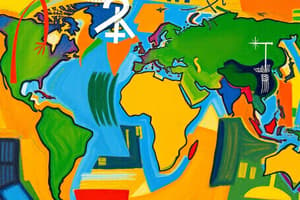Podcast
Questions and Answers
What main feature characterizes globalisation in the context of international business?
What main feature characterizes globalisation in the context of international business?
- Separation of goods and services across borders
- Reduction of tariffs and quotas (correct)
- Growing isolation of national markets
- Increase in domestic production only
Which of the following entry modes allows firms to minimize investment while testing foreign markets?
Which of the following entry modes allows firms to minimize investment while testing foreign markets?
- Joint ventures
- Wholly owned subsidiaries
- Exporting (correct)
- Franchising
What is a notable challenge associated with globalisation?
What is a notable challenge associated with globalisation?
- Reduction in technological advancements
- Increased trade tariffs
- Decreased consumer preferences
- Widening income inequality (correct)
What advantage do licensing agreements provide to firms entering foreign markets?
What advantage do licensing agreements provide to firms entering foreign markets?
Which of the following best describes a wholly owned subsidiary?
Which of the following best describes a wholly owned subsidiary?
What is an example of convergence in consumer preferences due to globalisation?
What is an example of convergence in consumer preferences due to globalisation?
Which of the following best describes the role of the World Trade Organization (WTO) in international business?
Which of the following best describes the role of the World Trade Organization (WTO) in international business?
What factor is NOT considered a driver of globalisation?
What factor is NOT considered a driver of globalisation?
What is a key characteristic of Japan's collectivist culture regarding decision-making?
What is a key characteristic of Japan's collectivist culture regarding decision-making?
Which aspect is NOT included in Corporate Social Responsibility (CSR)?
Which aspect is NOT included in Corporate Social Responsibility (CSR)?
How do fixed exchange rates impact monetary policy flexibility?
How do fixed exchange rates impact monetary policy flexibility?
What role does the International Monetary Fund (IMF) play in the global economy?
What role does the International Monetary Fund (IMF) play in the global economy?
What ethical dilemma can negatively affect a company's reputation?
What ethical dilemma can negatively affect a company's reputation?
What is a potential consequence of a depreciating local currency for a business?
What is a potential consequence of a depreciating local currency for a business?
Which of the following best explains sustainability in the context of business?
Which of the following best explains sustainability in the context of business?
What method do companies use to mitigate financial risks like currency volatility?
What method do companies use to mitigate financial risks like currency volatility?
What does Adam Smith’s absolute advantage theory emphasize for countries engaging in trade?
What does Adam Smith’s absolute advantage theory emphasize for countries engaging in trade?
How does David Ricardo's comparative advantage theory differ from absolute advantage?
How does David Ricardo's comparative advantage theory differ from absolute advantage?
What does the Heckscher-Ohlin model focus on regarding trade patterns?
What does the Heckscher-Ohlin model focus on regarding trade patterns?
Which situation illustrates the Product Life Cycle theory?
Which situation illustrates the Product Life Cycle theory?
What is a key characteristic of emerging markets?
What is a key characteristic of emerging markets?
What strategy does a multinational corporation following a transnational approach adopt?
What strategy does a multinational corporation following a transnational approach adopt?
How does culture influence international business practices?
How does culture influence international business practices?
What role does government intervention play in international trade?
What role does government intervention play in international trade?
What type of legal system relies on case precedents?
What type of legal system relies on case precedents?
Which type of strategy prioritizes local adaptation within multinational corporations?
Which type of strategy prioritizes local adaptation within multinational corporations?
What challenge do multinational corporations commonly face?
What challenge do multinational corporations commonly face?
What characterizes Hofstede’s cultural dimension of high power distance?
What characterizes Hofstede’s cultural dimension of high power distance?
Which of the following is an example of trade intervention by the government?
Which of the following is an example of trade intervention by the government?
Flashcards
What is International Business?
What is International Business?
Transactions that involve goods, services, and resources across national borders. These transactions encompass trade, foreign investment, and the transfer of knowledge.
Explain Globalisation
Explain Globalisation
The increasing interconnectedness of national markets and industries. This process is driven by advancements in technology, policy shifts towards free trade, and the convergence of consumer preferences.
What is the role of trade agreements like GATT and WTO?
What is the role of trade agreements like GATT and WTO?
Agreements that reduce tariffs and quotas, promoting smoother trade flows globally.
What is Exporting?
What is Exporting?
Signup and view all the flashcards
What is Licensing?
What is Licensing?
Signup and view all the flashcards
What is Franchising?
What is Franchising?
Signup and view all the flashcards
What is a Joint Venture?
What is a Joint Venture?
Signup and view all the flashcards
What are Wholly Owned Subsidiaries?
What are Wholly Owned Subsidiaries?
Signup and view all the flashcards
Ethics in International Business
Ethics in International Business
Signup and view all the flashcards
Corporate Social Responsibility (CSR)
Corporate Social Responsibility (CSR)
Signup and view all the flashcards
Floating Exchange Rate
Floating Exchange Rate
Signup and view all the flashcards
International Monetary System
International Monetary System
Signup and view all the flashcards
Hedging
Hedging
Signup and view all the flashcards
Adapting to Cultural Norms
Adapting to Cultural Norms
Signup and view all the flashcards
Ethical Dilemma
Ethical Dilemma
Signup and view all the flashcards
Sustainability
Sustainability
Signup and view all the flashcards
Comparative Advantage
Comparative Advantage
Signup and view all the flashcards
Heckscher-Ohlin Model
Heckscher-Ohlin Model
Signup and view all the flashcards
Absolute Advantage
Absolute Advantage
Signup and view all the flashcards
Product Life Cycle Theory
Product Life Cycle Theory
Signup and view all the flashcards
New Trade Theories
New Trade Theories
Signup and view all the flashcards
Emerging Markets
Emerging Markets
Signup and view all the flashcards
Transnational Strategy
Transnational Strategy
Signup and view all the flashcards
Global Strategy
Global Strategy
Signup and view all the flashcards
Multi-domestic Strategy
Multi-domestic Strategy
Signup and view all the flashcards
Totalitarian Regimes
Totalitarian Regimes
Signup and view all the flashcards
Democracies
Democracies
Signup and view all the flashcards
Civil Law
Civil Law
Signup and view all the flashcards
Common Law
Common Law
Signup and view all the flashcards
Religious Law
Religious Law
Signup and view all the flashcards
Protectionism
Protectionism
Signup and view all the flashcards
Study Notes
International Business and Globalization
- International business encompasses transactions like trade, investment, and knowledge transfer across borders.
- Globalization, a key driver, increases national market interconnectedness, driven by tech (communications, logistics) and policy shifts (trade liberalization).
- The GATT and WTO reduced trade barriers, facilitating smoother global trade.
- Globalization drivers include technological advancements, economic liberalization, and converging consumer preferences (e.g., smartphones, fast food).
- Globalization challenges include environmental degradation, income inequality, and cultural homogenization.
Alternative Routes to Internationalization
- Firms internationalize via various entry modes with varying risk levels and advantages.
- Exporting is a common initial step, with direct (firm-buyer) and indirect (intermediaries) variations.
- Licensing allows foreign firms to use trademarks or technology, reducing risk and control.
- Franchising provides a complete business model; an example is McDonald's.
- Joint ventures share risks and resources with local partners, particularly in complex markets.
- Wholly owned subsidiaries provide full control but entail higher operational risk; e.g., Toyota's factories in North America.
- Entry mode selection depends on resources, risk tolerance, and market potential.
Theories of International Trade
- International trade theories explain why countries trade and gain.
- Absolute advantage (Adam Smith): Specialization in goods produced most efficiently.
- Comparative advantage (David Ricardo): Benefit even if a country is less efficient in all goods (lowest opportunity cost specialization).
- Heckscher-Ohlin model: Trade based on factor endowments (resources). Examples include oil-exporting nations or garment exports from labor-abundant countries.
- Product Life Cycle theory: Trade shifts from developed to developing nations, following product innovation, standardization, and manufacturing.
- New trade theories (economies of scale and product differentiation): Important for impactful global markets. Example: Airbus and Boeing's dominance.
Overview of Emerging Markets
- Emerging markets are transitioning from developing to developed.
- Rapid industrialization and integration into the global economy. Examples include China's recent transformation.
- Characterized by increasing GDP growth rates, urbanisation, and expanding middle classes with rising purchasing power; e.g., India, Brazil, and South Africa.
- Governments in emerging markets attract FDI through policies like tax incentives and infrastructure. Example: China's Special Economic Zones.
- Opportunities include large consumer bases and cost-effective labor, accompanied by challenges. Examples include political instability, corruption, and complex regulations and underdeveloped infrastructures.
MNCs and Their Strategies
- Multinational Corporations (MNCs) operate globally, balancing global efficiency with local needs.
- Global strategy: Standardizes products for global markets, resulting in economies of scale (e.g., Coca-Cola).
- Transnational strategy: Balances global integration with local responsiveness (e.g., Unilever, adapting to local tastes, but benefiting from shared global resources.)
- Multi-domestic strategy: Prioritizes adaptation to local markets (e.g., McDonald's menus).
- MNC challenges: managing cultural diversity, regulations, and political risks, e.g. trade disputes such as US-China tensions.
Political and Legal Foundations
- Political systems (democracies vs. totalitarian regimes) and legal systems (common, civil or religious law) affect business operations.
- Political risks like nationalization, corruption, and trade restrictions threaten businesses; e.g., Venezuelan nationalizations.
- Understanding and adaptation to these systems are crucial for mitigating risks.
Government Intervention
- Governments intervene in trade to protect domestic industries, national security, and economic growth; examples of intervention tools include tariffs (taxes), quotas (limit quantities), and subsidies (financial support for local producers).
- EU agricultural subsidies illustrate protection, but potentially distort trade.
- Balance between free trade and protectionism is essential for sustainable growth and international cooperation.
Cultural Environment of IB
- Culture profoundly influences business practices and interactions.
- Hofstede's cultural dimensions (individualism vs. collectivism, power distance, uncertainty avoidance) are crucial for understanding cross-cultural differences. Examples include Japan's collectivist culture's emphasis on consensus.
- Cultural adaptation is critical for success in international operations.
Ethics, CSR, and Sustainability
- Ethics in international business promote fairness and integrity, while CSR broadens perspectives to include legal, ethical, and philanthropic responsibilities. Patagonia's emphasis illustrates this.
- Sustainability focuses on balancing present and future needs, facing ethical dilemmas such as labor exploitation and environmental damage.
- Incorporating ethics benefits trust and long-term success.
International Monetary and Financial Environment
- The international monetary system (exchange rate systems) and institutions (IMF, World Bank) support global trade and investment.
- Fixed vs. floating exchange rates; Fixed rates offer stability but limit monetary policy flexibility.
- IMF assists countries facing balance of payments crises, while World Bank supports development projects.
- Financial risks (currency volatility, interest rate fluctuations) affect businesses. Hedging instruments (e.g., forward contracts, options) mitigate these risks.
Studying That Suits You
Use AI to generate personalized quizzes and flashcards to suit your learning preferences.




